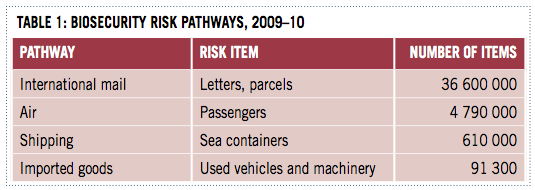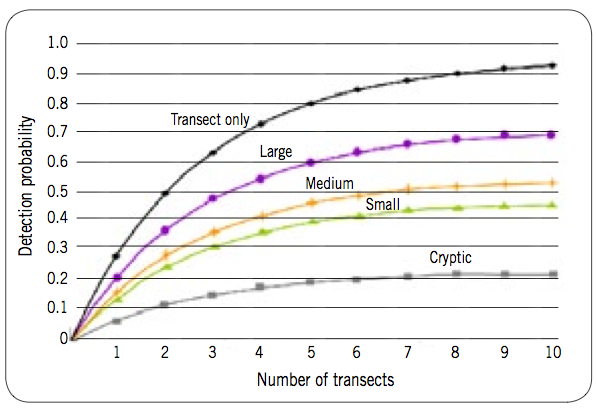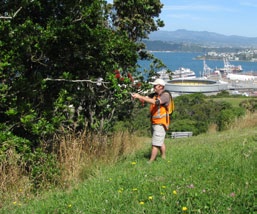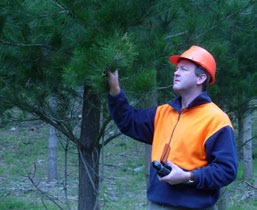PESTS AND DISEASES OF FORESTRY IN NEW ZEALAND
Forestry biosecurity surveillance in New Zealand
From SURVEILLANCE 38 (2) 2011.
Forest biosecurity surveillance is undertaken in New Zealand primarily to detect new forest pests. Currently this activity is shared between government and industry. The Ministry of Agriculture and Forestry (MAF) operates surveillance of high-risk sites (e.g., ports, Transitional Facilities, tourist attractions), maintains several specific pest-surveillance programmes, and promotes passive surveillance (detection of pests by the public, scien- tists, etc.). The New Zealand Forest Owners’ Association (FOA) administers surveys covering the large plantation forests. Both programmes are backed up by diagnostic expertise at the Crown Research Institute, Scion.
Nearly a quarter of New Zealand’s total area contains natural or indigenous trees that form an important part of our geographical and social identity.
Another 7 percent is planted in production forest, which forms an important part of our economic base. Covering 1.8 million hectares, production forests provide more than 3.2 percent of New Zealand’s GDP and provide employment to about 24 000 people. Urban trees and shelterbelts are also important, providing shade, shelter and even food, in what would otherwise be a drab environment.
The combined economic, environmental and ecological value of these forests is large. Forestry exports were worth over $4 billion in 2010, and the net value of New Zealand’s forests as carbon sinks is currently estimated at between $1.0 and $2.6 billion.
The challenge
 In 2009–10 the major pathways for biosecurity risk entering New Zealand were air passengers, sea containers, international mail and used vehicles (Table 1).
In 2009–10 the major pathways for biosecurity risk entering New Zealand were air passengers, sea containers, international mail and used vehicles (Table 1).
Prior to 2000, risk pathways were well defined and more centralised because most goods came in through the ports (sea and air) and emptying of containers (devanning) occurred on site at the ports. This enabled surveillance to be more centrally focused. . However, since then volumes have increased significantly and risk items need to be cleared from the port more quickly. For example, sea containers are usually removed from ports within 48 hours of unloading from the ship and moved to one of the 6000 registered Transitional Facilities around New Zealand for devanning. Surveillance at Transitional Facilities is now an important part of the programme.
Tourism is also a recognised pathway for entry of exotic organisms. Although baggage and personal effects are inspected at ports of entry, this is not 100 percent effective in detecting exotic organisms. For example, studies have shown that soil on footwear belonging to international passengers can contain viable pathogenic organisms such as fungi or nematodes (Young et al., 2007; M. McNeill, pers. comm.). Overseas studies have also shown that significant forestry pathogens such as Phytophthora ramorum can be spread carried on soil sttached to shoes (Davidson et al., 2005; Tjosvold et al., 2002).
A major concern is where tourists initially camp after arriving in New Zealand, exposing tents and other equipment for the first time. For example Gadgil and Flint (1983) found debris that harboured pathogenic fungi and live insects in tents accompanying tourists arriving at Auckland airport. Even just visiting scenic tourist spots and walking through indigenous forests has the potential to introduce exotic micro-organisms and weeds.
History of forest biosecurity surveillance
In 1953 the government engaged a prominent Canadian forest pathologist, J.J. de Gryse, to make recommendations to safeguard exotic forests from the threat of insects and pathological epidemics. One of his recommendations (de Gryse, 1955) was a system of forest health surveillance by means of a detection survey. In the late 1960s the emphasis of forest-health surveys changed from pest-population sampling to detecting new forest- health problems. Then in the early to mid-1970s regular surveys of port environs were started. The formal Port Environs Survey began in the late 1980s and targeted air and sea ports as major pest pathways into New Zealand (Carter, 1989). Bulman (2008) provides an excellent review of the history of forestry surveillance related to high-risk sites in New Zealand.
Methodology
HIGH RISK SITE SURVEILLANCE PROGRAMME
MAF’s main forestry-related surveillance programme is the High Risk Site Surveillance (HRSS) programme. HRSS is a post-border, risk-targeted surveillance programme focused on pests of arborescent plants. It is pathway- focused through identification of container facilities,
sea and air ports, and air passengers. It has three main aspects:
- intensive transect inspections that ensure programme repeatability and flexibility;
- extensive walkthrough between transects, which provides extra flexibility and ability to cover additional hotspots; and
- discretionary time to respond to new information, either from locals or by special instruction.
A database has been built and data integrated in a geographic information system (GIS). The programme has mapped about 5000 Transitional Facilities so they can be efficiently targeted by HRSS. Risk Site Areas are buffer zones around groups of higher-risk Transitional Facilities. This approach enables surveillance resources to be allocated based on the assumptions that:
- the greater the number of containers, the greater the biosecurity risk;
- inspection is more effective closer to the source of risk than further away; and
- new species will disperse in search of host material (e.g. insect pests may be host-specific or mildly polyphagous) and suitable hosts may not be close to Risk Site Areas. Therefore, inspecting nearby areas rich in vegetation, such as botanical gardens or arboreta, will add benefit for surveillance.
Transect inspections are intensive, with inspectors given time to thoroughly inspect vegetation even in the absence of obvious signs of damage. When a pest or damage is located, samples are taken and forwarded to forest diagnosticians at Scion, Rotorua, for identification. Results are notified to MAF within specified timeframes.
The actual pest detection probability of the HRSS programme combines interception probabilities (based on the numbers and shape/size of transects) and the detection probability within a transect (estimated from trials). Figure 1 shows the results of trials previously undertaken in Auckland (Baird, 2004) to examine feasibility, time required and detection probabilities for different visual classes (large, medium, small, cryptic). The “transect only” data estimates the likelihood that a transect will intercept a population of exotic organisms if there is one in the risk site area.

HRSS also covers pests that might potentially attack native forests, with more than half the host trees examined in transects being native plants. It also surveys a range of tourist risk sites, selected on the basis of visitor numbers, to provide extended biosecurity surveillance of the conservation estate.
MAF also runs a gypsy moth trapping programme using species-specific pheromones, owing to the recognised high risk of this pest arriving in New Zealand. In addition MAF runs a passive surveillance programme, with members of the public and other groups (e.g., scientists, service providers) asked to call an exotic pest and disease emergency hotline. Notifications through the hotline are screened and investigated to determine whether they represent a risk to New Zealand’s core biosecurity values. Significant numbers of notifications are received each year – for example a total of 26 289 in 2008 and 2009 (Froud et al., 2010). Of these, 7350 were referred by the call centre for further screening in the plant health and environment domains. Most of those (6197) were immediately eliminated as not signifying a biosecurity threat, while the remaining 1153 notifications were investigated in depth. About 20–30 percent of these investigations were forestry related.
FOREST HEALTH SURVEILLANCE SYSTEM
The New Zealand Forest Owners’ Association (FOA) is an industry group representing the interests of plantation owners and growers. It is very proactive with regard to biosecurity, spending $700,000 a year on surveillance.
To provide an additional line of defence for the forest industry, the FOA implements a Forest Health Surveillance (FHS) system across 1.2 million hectares of its members’ plantation forests. This scheme has been operating for more than 50 years, evolving as more knowledge has come to hand.
The FHS system aims at providing owners with information on forest health condition and pest status, as well as early detection of new pests. The sampling methodology utilises symptom-based inspection implemented using a three-layered approach:

- annual aerial surveys;
- drive-through surveys; and
- intensive inspection plots.
The aerial surveys entail transects a kilometre apart flown at a height of 300 m and a speed of about 70 knots. GPS is used to plot the flight paths and locations of significant symptoms, which are plotted on maps. Following analysis of the results, significant issues are followed up during the ground-based surveys.
On the ground, surveyors carry out drive-through surveillance at a speed of 15 kph to observe the surrounding forest. Sampling is carried out along transects (roads) at a minimum of 15 m per ha. Where visual symptoms indicate a potential problem, a closer inspection is made. GPS is used to record the track followed, and data are sent to the FOA for audit purposes. Research has shown that drive-through surveillance is of very similar efficiency to walk-through sampling (Bulman et al., 1999).
Investigative plots (at least two per thousand hectares) are set up to investigate symptoms seen during the aerial or drive-through survey. High-risk forest site plots are also
established to provide greater surveillance of high-risk sites of particular concern.
In addition to this national surveillance programme, individual companies send employees on forest health training courses, leading to a National Certificate in Forest Health Surveillance. This produces a workforce trained to identify biosecurity threats in the field.

DIAGNOSTICS
Accurate and rapid identification of samples collected in the field is a critical component of any surveillance programme. Achieving this is not simple in biosecurity surveillance, as species found may be new to New Zealand, new to science, or not previously associated with a particular host. Samples found as part of the MAF HRSS and the FOA FHS programmes are submitted to Scion, whose staff have vast experience with relevant forest fauna and flora, backed up by extensive collections providing a unique resource. Combining this with state-of-the-art technology helps to produce rapid and reliable identifications for forestry-related biosecurity surveillance.
Scion also identifies pests of trees and forest products submitted by the public. Information from this work provides another input into MAF’s national passive surveillance programme.
EXTERNAL VALIDATION
Forestry surveillance undergoes a constant review process to ensure that it is meeting the needs of the industry. Significant reviews of FHS and HRSS took place in 1998 (Bulman et al., 1999), 2003 (Moore et al., 2003), 2004 (Murphy, 2004) and 2008 (Kriticos et al., 2008).
Also, in November 2007 FOA commissioned a major external review of national forestry surveillance by two overseas experts. Dr Andrew Liebhold, a research entomologist with the USDA Forest Service in Virginia, and Dr Brenda Callan, a pathologist with the Canadian Forest Service in Victoria, BC, agreed that the current surveillance programme in commercial forests “is well-designed to detect new arrivals in time such that eradication may be feasible [and] nicely complements program[me]s for surveillance of high-risk areas conducted by MAF”.
THE FUTURE
In recent years both FHS and HRSS have implemented data capture using personal data assistants (PDAs) in the field to reduce data errors associated with double entry (previously information was recorded on paper forms and then retyped), and to speed up transfer of data into the Forest Health database. The Forest Health database is a web-based tool that stores the surveillance data and
enables individual forest owners to interrogate data relating solely to their own forests.
The FOA is in the process of developing a forest condition monitoring programme to measure changes in forest condition over time. This is a hybrid programme using ground-based measurements and aerial surveillance (i.e., light detection and ranging, or LIDAR). The forest industry is also evaluating other aerial tools (e.g., RapidEye) that can be used to measure forest health.
REFERENCES
Bulman, L S (2008) Pest detection surveys on high-risk sites in New Zealand. Australian Forestry 71(3): 242–244.
Bulman, L S; Kimberley, M O; Gadgil, P D (1999) Estimation of the efficiency of pest detection surveys. New Zealand Journal of Forestry Science 29: 102–115.
Carter, P C S (1989) Risk assessment and pest detection surveys for exotic pests and diseases which threaten commercial forestry in New Zealand. New Zealand Journal of Forestry Science 19: 353–374.
Davidson, J M; Wickland, A C; Patterson, H A; Falk, K R; Rizzo, D.M. (2005) Transmission of Phytophthora ramorum in mixed-evergreen forest in California. Phytopathology 95: 587–596.
de Gryse, J.J. (1955) Forest Pathology in New Zealand. New Zealand Forest Service Bulletin 1, NZ Forest Service, Wellington.
Froud, K J; Bullians, M S (2010) Investigation of biosecurity risk organisms for the plant and environment domains in New Zealand for 2008 and 2009. New Zealand Plant Protection 63: 262–269.
Gadgil, P D; Bulman, L S; Crabtree, R N; Watson, R N; O’Neill, J C; Glassey, K L (2000) Significance to New Zealand forestry of contaminants on the external surfaces of shipping containers. New Zealand Journal of Forestry Science 30: 341–358.
Gadgil, P D; Flint, T N (1983) Assessment of the risk of introduction of exotic forest insects and diseases in imported tents. New Zealand Journal of Forestry 28: 58–67.
Kriticos, D J; Leriche, A; Bulman, L S; Kimberley M O, Alcaraz, S; Richardson, B (2008) Modelling the efficacy of different sampling strategies for estimating disease levels and detecting the spread of new pests. Client Report 12697. Scion, Rotorua (unpublished).
Moore, J R; Ball, R D; Bulman, L S (2003) Review of the Effectiveness of Forest Health and Biosecurity Surveillance Programmes. Internal report. NZ Forest Research Institute Ltd, Rotorua (unpublished).
Murphy, B D. (2004) The Status and Future Needs of Forest Biosecurity Surveillance in New Zealand: A Discussion Document (June 2004). Ministry of Agriculture and Forestry, Wellington.
Tjosvold, S A; Chambers, D L;Davidson, J M; Rizzo, D M (2002) Incidence of Phytophthora ramorum inoculum found in soil collected from a hiking trail and hikers’ shoes in a California park [abstract]. Page 53 in Proceedings of Sudden Oak Death, A Science Symposium, USDA Forest Service and University of California, Berkeley, California, USA.
Young, S D; McNeill, M R; Gerard, E M; Phillips, C B; O’Callaghan, M (2007) Microbes associated with dirty shoes intercepted at New Zealand’s international airports. New Zealand Plant Protection 60: 311.
Paul Stevens
Senior Adviser
Biosecurity Surveillance (Plants Environment and Marine) Ministry of Agriculture and Forestry
Lindsay Bulman
Project Leader,
Forest Biosecurity
Scion
Private Bag 3020
Rotorua
Bill Dyck
NZFOA Forest Biosecurity Manager PO Box 1208
Wellington 6140

 Farm Forestry New Zealand
Farm Forestry New Zealand

